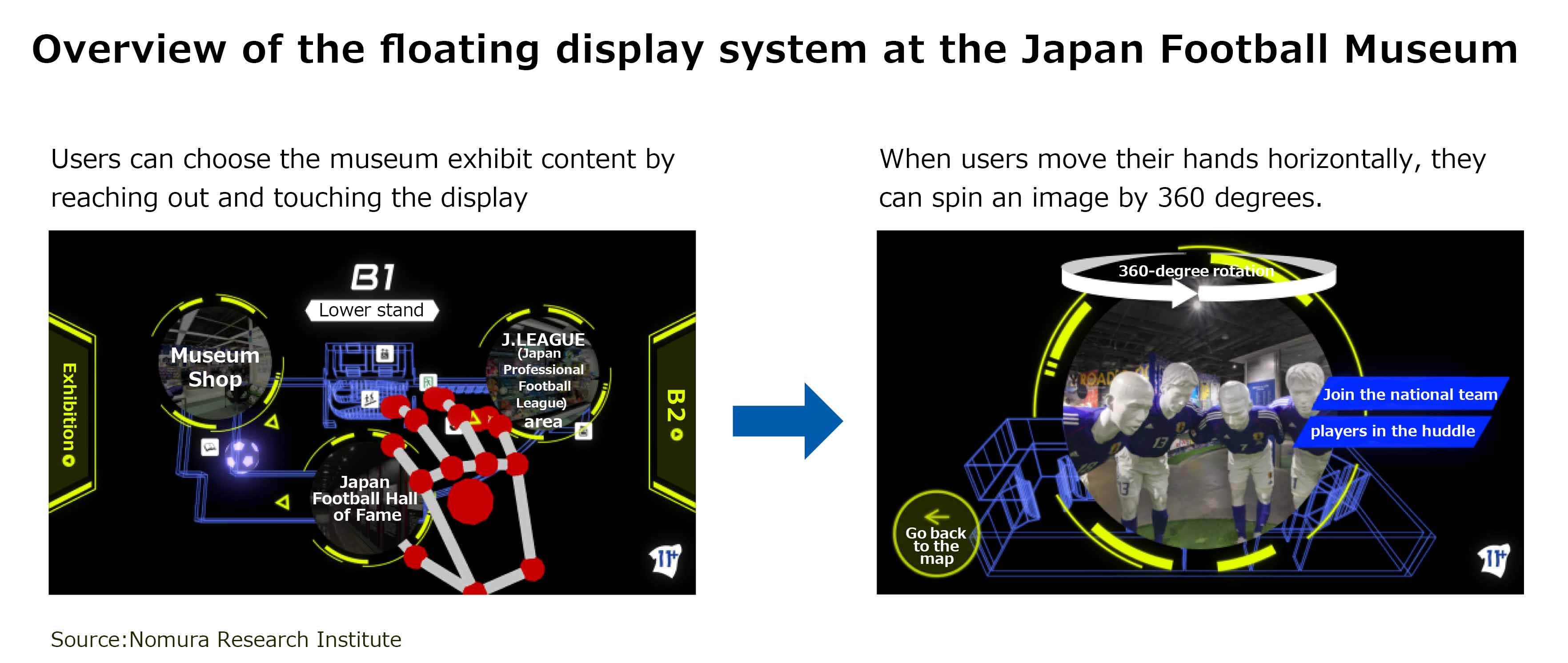
What Can A Non-Touch “Floating Display” Do? Floating Display at Japan Football Museum Shows Us The Future
NRI has supported the Japan Football Association (JFA), an organization dedicated to promoting soccer culture in Japan and to player development, through its information systems. One such system is the floating image display system installed at the Japan Football Museum in March 2018. We interviewed NRI member and 3D technology expert Toru Hamabe about what floating image display systems—which use cutting-edge virtual reality technology—can really do, and how they will advance going forward.
Things That Happen In Movies Now Happen In Real Life
You may have watched scenes from Sci-Fi movies where someone raises his or her hand and causes images of multiple screens to appear mid-air, which the person then operates smoothly. There are places where you can experience such scenes from movies in real life, one being the Japan Football Museum in Tokyo’s Bunkyo Ward.
When you enter the museum, you’ll see a display that looks as if it is floating in the air. You can use your hand to move it and view part of the museum’s exhibitions from different angles.
This system was developed and installed by NRI. Toru Hamabe, who is in charge of the system, is a 30-year veteran researcher who has worked on 3D technologies and expressing virtual environments.
“2016 was called ‘The Year of Virtual Reality’ and virtual reality (VR) and augmented reality (AR) caused a buzz, but floating image displays are finally being commercialized. By making the Japan Football Museum one of the first venues to get a state-of-the-art floating display system, we hoped to help the museum draw attention and further enhance its name recognition. We hope many people will experience the floating display at the Japan Football Museum firsthand.”
NRI provides IT support to JFA’s “Yume-no-Kyoshitsu” program that brings athletes to classrooms. In 2015, NRI developed JFA’s ID integrated management platform JFA ID system and the KICKOFF system for managing player, referee and coach qualification data. The JFA ID system takes registrations of not only pro players but also kids who play in football clubs as well as fans, meaning it connects all people involved in soccer.

Floating Display Needs No Smartphones or Headsets
The floating display system is one of the devices that show VR and AR, which have been talked about recently.
VR is a three-dimensional virtual space created in a computer. You use a dedicated headset to experience the world of a virtual space as if in real life. It is used in video games, attractions, and training simulators.
AR is for displaying virtual perceptual information on top of a real-world scene. Well-known examples include smartphone users seeing a video game character appear on the screen when the phone is pointed to the street or getting an idea of how a room would look with furniture.
“With VR, which requires a dedicated headset, people can see a space only through the headset. But floating displays can be installed anywhere as long as there is enough room for the equipment, and we expect the displays to be used broadly going forward. This is why NRI is continuing experimental efforts for the commercialization of floating displays,” Hamabe says.
Applications Include Train Station Information Boards, Museum Exhibitions
Floating displays, which show a 3D object out of thin air, requires not only VR and AR but sensing and various other technologies. R&D is taking place all over the world, with some methods using lasers and others casting images onto smoke.
“We at NRI are working on a method that has images permeate glass embedded with a reflective mirror and make them appear. This is a more cost-effective method than others.”
However, floating displays take time to develop, Hamabe says.
“This is because sensor control is extremely difficult. Display operation can be broken down into many different steps, such as a hand is moved, then a finger is entered, and the moment that the finger is removed, the system has to react. Floating displays are made possible by a sensing algorithm that measures and digitizes information from the sensor, but this requires an enormous volume of experiential data.”
NRI already uses floating displays as a prompter for internal seminars and as access control for data centers.
“The advantage of floating displays is that there’s no physical monitor and so there’s nothing that blocks a space. Unlike a touch screen, a user doesn’t need to touch anything directly, so we can avoid equipment breakdowns caused by touching. No touching means a more hygienic alternative, and no chance your fingerprints will be taken, either. We think that, down the road, floating displays can be used as information boards at hospitals and other hygiene-sensitive facilities, information panels at museums that don’t get in the way of exhibits, conference room monitors, advertisements on trains, and information boards at train stations, to name just a few of many other applications.”
The floating display system at the Japan Football Museum embodies our wish: to get children interested in what is to come in the next generation by showing it with today’s cutting-edge technologies.

Related link
Profile
-
Toru Hamabe
* Organization names and job titles may differ from the current version.